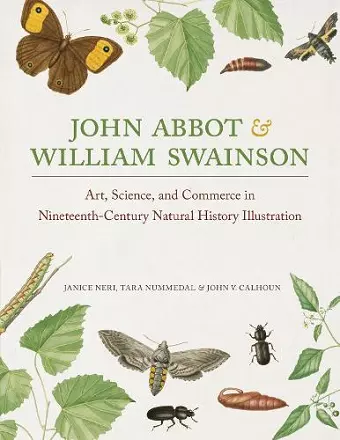John Abbot and William Swainson
Art, Science, and Commerce in Nineteenth-Century Natural History Illustration
Janice Neri author Tara Nummedal author John V Calhoun author
Format:Hardback
Publisher:The University of Alabama Press
Published:30th Apr '19
Should be back in stock very soon

An archive of never-before-published illustrations of insects and plants painted by a pioneering naturalist.
During his lifetime (1751–ca. 1840), English-born naturalist and artist John Abbot rendered more than 4,000 natural history illustrations and profoundly influenced North American entomology, as he documented many species in the New World long before they were scientifically described. For sixty-five years, Abbot worked in Georgia to advance knowledge of the flora and fauna of the American South by sending superbly mounted specimens and exquisitely detailed illustrations of insects, birds, butterflies, and moths, on commission, to collectors and scientists all over the world.
Between 1816 and 1818, Abbot completed 104 drawings of insects on their native plants for English naturalist and patron William Swainson (1789–1855). Both Abbot and Swainson were artists, naturalists, and collectors during a time when natural history and the sciences flourished. Separated by nearly forty years in age, Abbot and Swainson were members of the same international communities and correspondence networks upon which the study of nature was based during this period.
The relationship between these two men—who never met in person—is explored in John Abbot and William Swainson: Art, Science, and Commerce in Nineteenth-Century Natural History Illustration. This volume also showcases, for the first time, the complete set of original, full-color illustrations discovered in 1977 in the Alexander Turnbull Library in Wellington, New Zealand. Originally intended as a companion to an earlier survey of insects from Georgia, the newly rediscovered Turnbull manuscript presents beetles, grasshoppers, butterflies, moths, and a wasp. Most of the insects are pictured with the flowering plants upon which Abbot thought them to feed. Abbot’s journal annotations about the habits and biology of each species are also included, as are nomenclature updates for the insect taxa.
Today, the Turnbull drawings illuminate the complex array of personal and professional concerns that informed the field of natural history in the eighteenth and nineteenth centuries. These illustrations are also treasured artifacts from times past, their far-flung travels revealing a world being reshaped by the forces of global commerce and information exchange even then. The shared project of John Abbot and William Swainson is now brought to completion, signaling the beginning of a new phase of its significance for modern readers and scholars.
“This beautifully illustrated work represents the 19th-century collaboration between two artist-naturalists, John Abbot (1751–c.1840) and William Swainson (1789–1855). This complete set of Abbot’s original, full-color drawings includes beetles, grasshoppers, butterflies, and moths. It should delight naturalists, artists, and historians of science.”- CHOICE;
“I believe this work, by including reproductions of 104 drawings, will add substantively to the limited information available to the public about Abbot and his devotion to entomology during the early part of the ‘golden age’ of natural history.”- Gary R. Mullen, coeditor of Philip Henry Gosse’s Letters from Alabama: Chiefly Relating to Natural History;
“A panoply of winged insects comes brilliantly to life in Janice Neri’s studious account of John Abbott’s never-before-published entomological drawings. Their global journey—from the tidewaters of Georgia to the windy shores of Wellington—reveals a naturalist’s world that is as interconnected as it is fragile and fleeting, like the delicate wings of a rare butterfly, observed for a moment until it flies away.”- Neil Safier, director and librarian, John Carter Brown Library;
“Janice Neri’s keen eye for beautiful images that illuminate the entwinement of art and science is alive in this analysis of a much-traveled and hitherto unstudied set of watercolors. These images depict some of the most perplexing subjects of natural history—the life cycles and metamorphoses of insects, matters at the heart of the study of nature for centuries. Her sensitive historical account of the people and places that gave rise to this investigation and produced these images takes us back to a time when natural history could be a business, a mark of gentility and status, and a type of knowledge that promised an escape from such human structures. Thanks to Nummedal and Calhoun, Neri’s voice emerges loud and clear from this intelligent and informative account.”- Pamela H. Smith, author of The Business of Alchemy: Science and Culture in the Holy Roman Empire and The Body of the Artisan: Art and Experience in the Scientific Revolution
ISBN: 9780817320133
Dimensions: unknown
Weight: 1585g
256 pages